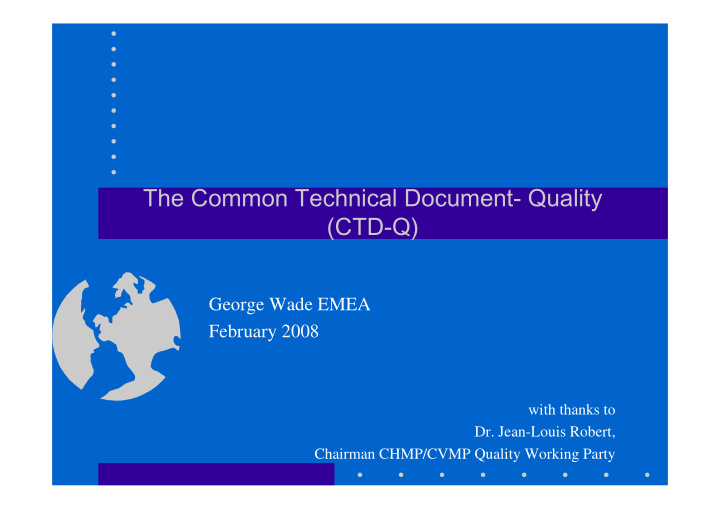



The Common Technical Document- Quality (CTD-Q) George Wade EMEA February 2008 with thanks to Dr. Jean-Louis Robert, Chairman CHMP/CVMP Quality Working Party
CTD : what is it? • IT IS : A common harmonised FORMAT for applications for preparing marketing authorisations in the three ICH regions. a TEMPLATE for presenting data in the dossier. • IT IS NOT: A statement of data requirements for applications
CTD : regulatory sources • Notice to Applicants , Eudralex Vol. 2B : “NTA Guidance” June 2006 : Structure is defined here. http://ec.europa.eu/enterprise/pharmaceuticals/eudralex/vol- 2/b/ctd_06-2006.pdf • Q&A Document http://www.ich.org/LOB/media/MEDIA620.pdf • ‘Location issues’ ( Quality ) - see CPMP/ICH/4680/02 • ICH Updates http://www.ich.org
Diagrammatic 1 → not strictly part of CTD Regional Representation Administrative Information Non-clinical Clinical Overview Overview Quality Module 2 Non-clinical Clinical Overall ( Summaries) Written and Written Summary Tabulated Summary Summaries 2.3 3 4 5 Quality Non-clinical Clinical Study Study Reports Reports
CTD-Q basic structure • MODULE 1 Admin and Regional Specific Information Don’t forget molecular structure aspects re: Similarity (1.7) - although these are outside the main quality/safety/efficacy benefit-risk evaluation for an authorisation. • MODULE 2 CTD Summaries – Quality Overall Summary (2C) - QOS • MODULE 3 Main body of Quality Data i.e. The Q dossier will be basically modules 2.3 & 3
Module 1: Administrative Regional Information • 1.1 Table of Contents • 1.2 Application forms • 1.3 Product Information, SPC/Labelling/ Package Leaflet • 1.4.1 Expert declarations & signatures for the QOS • 1.5 ‘Specific Requirements’ for types of application bibliographic, generic, biosimilar, informed consent etc. • 1.6 Environmental Risk Assessment (GMO? ) • 1.7 Orphan issues, structural similarity • 1.8, 1.9 Pharmacovigilance and Clinical Trials
Module 2: Quality Overall Summary • This is probably what EU assessors will read first • Quality Overall Summary – Written text summary following the outline and scope of the ‘Body of Data’, Module 3 . – Not required to be critical – No formal tabulated summary structure – Key parameters of the active substance & product which may have an impact on efficacy or safety should be emphasised – Relevant tables/figures could be incorporated – External Drug Master File (ASMF Open part ) will be summarised here. Closed/Restricted part should be in the ASMF itself.
Module 3: CTD-Q ( guideline ) Note : Same structure for ‘ NCE ’ & ‘ Biotech ’ products Scope of the guidance , i.e. format • 3.1 Table of Contents – helpful to assessors • 3.2 Body of Data ’ • 3.2.S Drug Substance External Drug Master File ( ASMF ) should also follow this structure for both the Open and Closed/Restricted parts. • 3.2.P Drug Product – 3.2.A Appendices • A.1 Facilities and equipment ( biotech) • A.2 Adventitious Agents contamination • A.3 Excipients ( novel )
Scope • Addresses the format/structure of applications for MAs of active substances and their corresponding drug products. • NTA Guidance : The text following the section titles is intended to be explanatory and illustrative only i.e. It merely indicates the location where information has to be provided. • The actual content of these sections in the dossier should include relevant information described in existing CHMP- and CHMP-ICH guidelines • The section Regional Information addresses information unique to this region
Example of a ‘network’: Polymorphism • Cross reference between section P2 (Pharm. Development) and relevant sections in S (Drug Substance) and in P (Drug Product) – S 1.3 Properties of the active substance – S.2 Manufacture – S 3.1 Studies on Polymorphism (experimental data) – S 4.1 Specifications relating to control of physical forms – S.4.3 Analytical methods used – S 4.5 Justification of Specifications – P 2: Influence of the polymorphic forms on product characteristics – dissolution, stability , etc. – P 5.1 Product Specifications, need to control polymorphs? – P 5.6 Justification of Specifications
Body of Data – 3.2.A: Appendices • A 1 Facilities and Equipment: applies for Biotech. products • A 2 Adventitious Agents Safety Evaluation: applies for NCEs and Biotech; including TSE requirements viral inactivation studies, etc.
Body of Data 3.2.R : Regional • Process Validation scheme, manufacture of product • Medical Devices, if included in the presentation of the product, CE-mark info. etc. • Certificates of Suitability , where relevant (e.g. generics ?) • Materials of animal and/or human origin
issues • Implementation not equal in all regions? • Nothing to do with e-CTD ( although the e-CTD is of course based on the agreed CTD structure ) • In EMEA, for publication purposes (EPARS) we still prefer to avoid ‘drug’ Drug substance becomes Active Substance Drug Product becomes Medicinal Product
Conclusions • Benefit for industry – Format: yes, better utilisation of global resources – Content: identical within the 3 regions but can it lead to an expectation of more data ? • Benefit for regulators – Format: yes, easy to evaluate in general – Content: same as before really, no change. • Benefit for the patient – Expedited evaluation is a benefit, especially with a positive conclusion and early marketing.
Recommend
More recommend